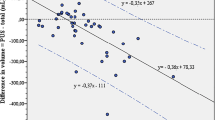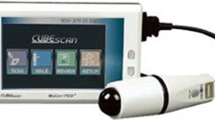Abstract
Our objective was to determine the reproducibility and validity of urine retention volumes measured by 3D ultrasonography (3D-US) 2 h postpartum. This was a longitudinal prospective study of 100 women who delivered vaginally. Each woman underwent five successive urine retention measurements with the Bladder Scan 2 h after vaginal delivery, followed by transurethral catheterization to determine the real volume. The reproducibility of only the last four scan values was analyzed with an intraclass correlation coefficient, and that of determinations 4 and 5 with a Bland–Altman plot. The validity of the device was similarly evaluated using the mean four-scan and real values. Pearson’s correlation coefficient was calculated and a least-trimmed squares robust linear-regression model was used. All tests were two-sided with a 5% α risk. Results showed that 3D-US measurements were highly reproducible, with an intraclass correlation coefficient of 0.974 (95% CI:0.964–0.981). 3D-US also accurately estimated the real urine volume (intraclass correlation coefficient 0.924; 95% CI:0.888–0.949), but tended to underestimate by about 6.8%. The between-technique Pearson correlation coefficient was 0.94 (P<0.0001) and the regression analysis gave an R 2 of 0.914. Urine retention volumes exceeded 500 ml in 55 women, and 1 l in 7. We concluded that 3D-US was reliably able to measure postpartum urine retention volume.

Similar content being viewed by others
Abbreviations
- 3D:
-
Three-dimensional
- SUI:
-
Stress urinary incontinence
- US:
-
Ultrasonography
References
Saultz JW, Toffler WL, Shackles JY (1991) Postpartum urinary retention. J Am Board Fam Pract 4:341–344
Watson WJ (1991) Prolonged postpartum urinary retention, Mil Med 156:502–503
Bent AE, Nahhas DE, McLennan MT (1997) Portable ultrasound determination of urinary residual volume. Int Urogynecol J 8:200–202
Barrington JW, Bowen-Simpkins P (1996) A comparison between portable ultrasound and urethral catheterisation in the measurement of female bladder volume. J Obstet Gynecol 16:50–51
Goode PS, Locher JL, Bryant RL, Roth DL, Burgio KL (2000) Measurement of postvoid residual urine with portable transabdominal bladder ultrasound scanner and urethral catheterization. Int Urogynecol J 11:296–300
Fuse H, Yokoyama T, Muraishi Y, Katayama T (1996) Measurement of residual urine volume using a portable ultrasound instrument. Int Urol Nephrol 28:633–637
Brouwer TA, Eindhoven GB (1999) Validation of an ultrasound scanner for determining urinary volumes in surgical patients and volunteers. J Clin Monit 15:379–395
Slappendel R, Weber EW (1999) Non-invasive measurement of bladder volume as an indication for bladder catheterisation after orthopaedic surgery and its effect on urinary tract infections. Eur J Anaesthesiol 16:503–506
Barrington JW, Edwards G, Ashcroft M, Adekanmi O (2001) Measurement of bladder volume following cesarean section using bladderscan. Int Urogynecol J 12:373–374
Donner A (1986) A review of inference procedures for the intraclass correlation coefficient in the one-way random effects model. Int Statist Rev 54:67–82
Shrout PE, Fleiss JL (1979) Intraclass correlation:uses in assessing rates reliability. Psychol Bull 86:420–428
Bland JM, Altman DG (1986) Statistical method for assessing agreement between two methods of clinical measurement. Lancet 1:307–310
Maymon R, Gilboa S, Abramowicz JS, Shulman A, Toar M, Bahary C (1991) Ultrasonic validation of residual bladder volume in postvaginal hysterectomy patients. Gynecol Obstet Invest 31:226–230
Chan H (1993) Noninvasive bladder volume measurement. J Neurosci Nurs 25:309–312
Salinas Casado J, Sanchez Blasco E, Virseda Chamorro M et al. (1996) Reliability of the estimate of post-voiding bladder volume with ultrasound. Comparison of 2 ultrasonography methods. Arch Esp Urol 49:35–40
Ding YY, Sahadevan S, Pang WS, Choo PW (1996) Clinical utility of a portable ultrasound scanner in the measurement of residual urine volume. Singapore Med J 37:365–368
Richter S, Hag’ag R, Shalev M, Nissenkom I (1999) Measuring residual urine by portable ultrasound scanner. Harefuah 137:93–95
Coombes GM, Millard RJ (1994) The accuracy of portable ultrasound scanning in the measurement of residual urine volume. J Urol 152:2083–2085
Groutz A (1999) Stress urinary incontinence: Prevalence among nulliparous compared with primiparous and grand multiparous premenopausal women. Neurourol Urodyn 18:419–425
Viktrup L (2000) Lower urinary tract symptoms 5 years after first delivery. Int Urogynecol J 11:336–340
Wilson PD, Herbison RM, Herbison GP (1996) Obstetric practice and the prevalence of urinary incontinence three months after delivery. Br J Obstet Gynaecol 103:154–161
Weissman A, Grisaru D, Shenhav M, Peyser RM, Jaffa AJ (1995) Postpartum surveillance of urinary retention by ultrasonography:the effect of epidural analgesia. Ultrasound Obstet Gynecol 6:130–134
Groutz A, Gordon D, Wolman I, Jaffa A, Kupferminc MJ, Lessing JB (2001) Persistent postpartum urinary retention in contemporary obstetric practice. Definition, prevalence and clinical implications. J Reprod Med 46:44–48
Acknowledgments
The authors would like to thank all the labor room nurses who participated in the study. They also express their gratitude to Janet Jacobson for translating this manuscript.
Author information
Authors and Affiliations
Corresponding author
Additional information
Editorial Comment: The authors provide strong evidence for the criterion validity and the test–retest reliability of bladder scan ultrasound measurements of residual urine volume during the immediate postpartum period in women who delivered vaginally under lumbar epidural or spinal anesthesia. It is unclear from the manuscript when it would be necessary to evaluate bladder volumes, residual or otherwise, during the immediate postpartum period in such women. The nursing staff or physicians can most often assess bladder volume by palpation in patients who have decreased bladder sensation because of afferent nerve blocks. This approach is neither invasive nor costly, compared to catheterization or bladder scanning.
Rights and permissions
About this article
Cite this article
Demaria, F., Amar, N., Biau, D. et al. Prospective 3D ultrasonographic evaluation of immediate postpartum urine retention volume in 100 women who delivered vaginally. Int Urogynecol J 15, 281–285 (2004). https://doi.org/10.1007/s00192-004-1159-3
Received:
Accepted:
Published:
Issue Date:
DOI: https://doi.org/10.1007/s00192-004-1159-3




